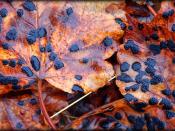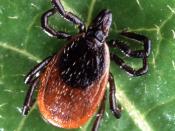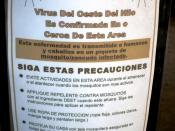Research paper about vector organisms such as ticks and mosquitoes and ways to remove them.
Vector Organisms and the Diseases They Carry
Vector organisms are parasites that transmit various diseases. Two vector organisms are ticks and mosquitoes. These two vector organisms transmit many well-known diseases. Through most of this essay, I will be explaining these two different organisms and the diseases that they carry.
First, I will be explaining deer ticks. Ticks are small spider-like organisms that attach themselves to a donor body. Male ticks are black. Females have a red abdomen and some black near the head. Adult ticks usually feed on deer but some times feed on humans accidentally. Deer ticks go through three life stages. The first stage is the larva. The larvae are small and tan colored. They usually feed on things like chipmunks, mice, and other small animals. Nymphs are a little bit larger than the larva.
They are beige with a dark head. Nymphs usually feed on larger animals such as birds and raccoons. The adults vary in color depending if they are males or females. They usually feed on cats, dogs, and humans. Deer ticks are usually found in grassy woodland areas or wide open plains. Deer ticks are more common in the eastern U.S. than in the western U.S.
Mosquitoes are small insects that have a very thin body. Mosquitoes can be found anywhere except for Antarctica. There are about 170 different species of mosquitoes in all of North America. To grow, mosquitoes need a small area of stagnant water. Mosquitoes have been known to breed in fresh water, salt-water marshes, or water found in old tires or plastic containers. The mosquito life cycle has 4 significant stages. They go from eggs to larvae to pupae and finally to adult. Only...


